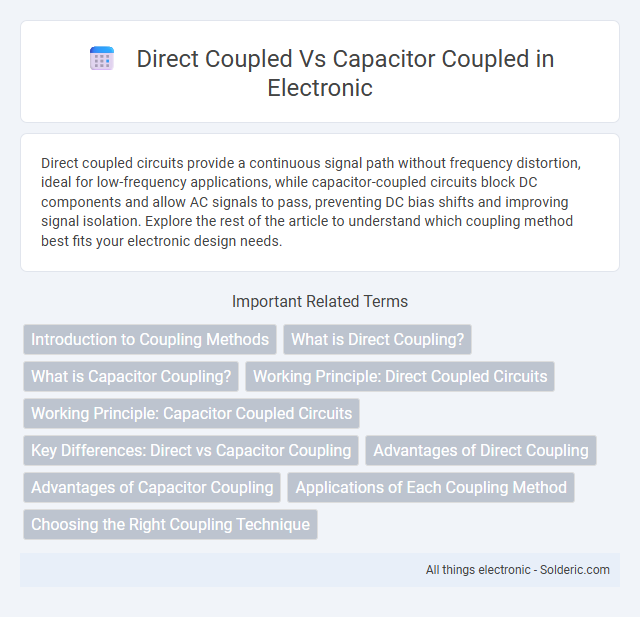Direct coupled circuits provide a continuous signal path without frequency distortion, ideal for low-frequency applications, while capacitor-coupled circuits block DC components and allow AC signals to pass, preventing DC bias shifts and improving signal isolation. Explore the rest of the article to understand which coupling method best fits your electronic design needs.
Comparison Table
| Feature | Direct Coupled | Capacitor Coupled |
|---|---|---|
| Coupling Method | Direct electrical connection | Uses capacitor to pass AC signals |
| Frequency Response | Wide frequency range, includes DC | Blocks DC, passes AC, limited low-frequency response |
| DC Isolation | No isolation, DC levels are transferred | Provides DC isolation between stages |
| Biasing Stability | More sensitive to DC bias shifts | Improves bias stability by blocking DC |
| Application | Low frequency amplifiers, DC amplifiers | Audio amplifiers, signal coupling, AC amplification |
| Component Size | No coupling component required | Requires suitable capacitor |
| Signal Distortion | Minimal distortion at low frequencies | Possible distortion at low frequencies due to capacitor |
Introduction to Coupling Methods
Direct coupled circuits establish a continuous DC path between stages, enabling low-frequency and DC signal transmission essential for amplifiers and sensor interfaces. Capacitor coupled circuits use capacitors to block DC components while allowing AC signals to pass, improving stability by eliminating DC offset and facilitating frequency response control. Understanding these coupling methods helps optimize your circuit design for signal integrity and performance across various frequency ranges.
What is Direct Coupling?
Direct coupling, also known as DC coupling, connects electronic components or stages without any intervening capacitors, allowing both AC and DC signals to pass through uninterrupted. This method preserves the full frequency range and maintains the signal's DC bias level, which is crucial for applications like amplifier circuits requiring steady biasing between stages. Direct coupling is often preferred in low-frequency or wideband designs where signal integrity and accurate DC response are essential.
What is Capacitor Coupling?
Capacitor coupling is a technique used in electronic circuits to transfer alternating current (AC) signals between stages while blocking direct current (DC) components, preserving signal integrity. This method employs capacitors to isolate the DC biasing of different circuit sections, preventing unwanted DC interference. When comparing direct coupled and capacitor coupled circuits, capacitor coupling excels in eliminating DC offset issues, making it ideal for amplifiers and signal processing applications where maintaining AC signal quality is crucial for your device's performance.
Working Principle: Direct Coupled Circuits
Direct coupled circuits transfer signals continuously through direct electrical connections without capacitive or inductive elements, allowing DC and low-frequency signals to pass unaltered. These circuits maintain signal integrity over a wide bandwidth by enabling direct current flow between stages, essential for applications requiring zero-frequency response. Their working principle relies on the direct conduction path, making them suitable for amplifiers and sensor interfaces where accurate DC signal representation is critical.
Working Principle: Capacitor Coupled Circuits
Capacitor-coupled circuits operate by allowing AC signals to pass through the coupling capacitor while blocking DC components, effectively isolating stages without affecting signal integrity. The capacitor charges and discharges in response to voltage changes, creating a path for alternating currents and preventing DC biasing from one stage to influence the next. This coupling technique enhances frequency response and minimizes distortion in amplifier and signal processing applications.
Key Differences: Direct vs Capacitor Coupling
Direct coupling allows signals to pass through without any frequency filtering, enabling both AC and DC components to be transmitted, which is ideal for low-frequency or DC signal amplification. Capacitor coupling blocks DC components, permitting only AC signals to pass, making it suitable for applications requiring isolation between circuit stages or the removal of DC offsets. Your choice between direct and capacitor coupling depends on whether you need to preserve DC levels or eliminate them for signal integrity.
Advantages of Direct Coupling
Direct coupling offers improved low-frequency response and enables the transmission of DC signals, which is essential for amplifier stages that require bias voltage continuity. It reduces phase distortion and simplifies circuit design by eliminating the need for coupling capacitors and associated reactive components. This method also enhances signal integrity in multi-stage amplifiers by maintaining consistent signal levels without frequency-dependent attenuation.
Advantages of Capacitor Coupling
Capacitor coupling offers the advantage of blocking DC components while allowing AC signals to pass, thus preventing DC bias from affecting subsequent stages. It enhances signal integrity by minimizing distortion and noise, especially in audio and communication circuits. This method also simplifies circuit design by eliminating the need for complex biasing arrangements in connected stages.
Applications of Each Coupling Method
Direct coupled circuits are widely used in low-frequency amplifier stages and digital circuits where zero frequency response and stable DC biasing are critical, such as operational amplifiers and transistor switches. Capacitor coupled circuits are preferred in audio frequency amplifiers, radio frequency stages, and signal processing units, enabling AC signal transmission while blocking DC components to prevent bias shifts between stages. Your choice depends on whether you require DC continuity for signal integrity or AC isolation to protect subsequent stages.
Choosing the Right Coupling Technique
Direct coupled circuits offer a seamless signal transfer without frequency distortion, making them ideal for low-frequency and DC applications where signal integrity is critical. Capacitor coupled circuits effectively block DC components while allowing AC signals to pass, suitable for AC signal amplification and frequency response adjustments. Selecting the right coupling technique depends on the application's frequency range, signal type, and the need for DC isolation or preservation.
Direct coupled vs Capacitor coupled Infographic

 solderic.com
solderic.com